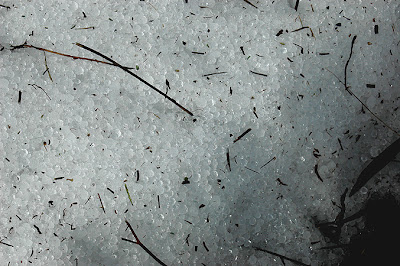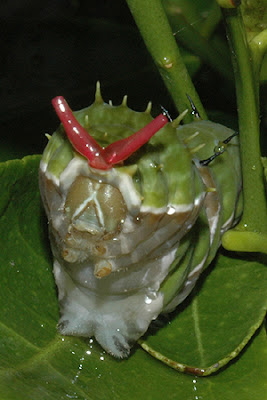
During the heavy rain, I rang David and he invited me around to his place to check out the Orchard Swallow-tailed Butterfly Caterpillars we had seen previously. When the rain eased, briefly, we went out to check on their growth. When seen previously (on 19 January) these guys were half-grown and brown and white coloured. The bird-dropping disguise. They have now grown to nearly full size. Now, as you can see this is one fat caterpillar, and it is armed with spiky protuberances.
 Indeed, when alarmed it can do this!
Indeed, when alarmed it can do this! That is a stunning display, and, if you check back to the top photo, you will see that those glands were not present, or not visible. The red glands appeared suddenly, when I lifted the leaf on which the caterpillar was feeding to take a close-up photo. Bingo, this is what I was presented with. I was impressed, and I am sure a "predator" would also have been "warned off". In fact those glands can produce a strong-smelling liquid (although it did not squirt me).
That is a stunning display, and, if you check back to the top photo, you will see that those glands were not present, or not visible. The red glands appeared suddenly, when I lifted the leaf on which the caterpillar was feeding to take a close-up photo. Bingo, this is what I was presented with. I was impressed, and I am sure a "predator" would also have been "warned off". In fact those glands can produce a strong-smelling liquid (although it did not squirt me).The front-on view of a caterpillar is not often seen as clearly as this. So lets have a close look. You can see a really clear, but accurate diagram of the body parts of a caterpillar, at the Chew Family's website on the Insects of Brisbane. That illustration is based upon a caterpillar of this species. That illustration will help you locate some of the named parts I am about to mention.
The creamy coloured "face" has an inverted V shape. Either side of the lower end of the V marks are small brown points, which are the eyes of the caterpillar (called "Stemmata") . There are apparently 6 tiny eyes, located together, on each side (I could not see that detail - that's where biologists come in handy, to explain things in fine detail for us). I can see where these eyes are, however.
The mouth is the "raison d'etre" for a Caterpillar, so it is very highly developed. Indeed if you have ever read to children, the wonderful book by Eric Carle, called the Very Hungry Caterpillar, you will know that all they do is eat!
Check this article in Wikipedia, on the mouth parts of chewing insects. The caterpillar's mouth parts consist of "mandibles" (jaws, used for cutting and chewing food) and maxillae (the hairy organs below the jaws, used for directing the chewed food into the mouth) and "palps" (which according to the Macquarie dictionary, are sense organs), so that the Caterpillar can feel what it is eating. Just as well, as it probably cannot see so close in front of its face.
Incidentally, "Osmeterium" (well, "osmeteria" probably) is the name for the pair of glands on the forehead. These are specific to caterpillars of the Swallowtail group of Butterflies (which includes the Orchard Butterfly). These glands can be "everted" (the word for when an internal organ is turned outwards, as required), when the animal is threatened.
 In this subsequent photograph, this second caterpillar was apparently happily walking along the Lemon Tree leaf, but with these glands fully extended. So, he was still saying "beware of me".
In this subsequent photograph, this second caterpillar was apparently happily walking along the Lemon Tree leaf, but with these glands fully extended. So, he was still saying "beware of me".And now to a Giant Earthworm (possibly Notoscolex grandis) I found today, at the wonderful lookout at Lee's Road, on the very edge of the Illawarra Escarpment. The worm was flooded out of its burrow. It had come out, and was lying in a puddle, so I rescued it (hopefully) by putting it back into some soil, and covered it over with leaves, to give it some chance of surviving. This one is at least 200 mm long (about 8 inches long). My camera lens cap covers a 62mm lens, and is therefore slightly larger than that. Of course, this worm when fit and healthy can stretch itself much longer than it is in this situation, when it was nearly drowned, and (to use an ugly word) quite "flaccid". It is the largest Earthworm I have found, since my time in Robertson. Greg found one at his place a few days ago - probably in the same situation as this one, nearly drowned.
 The article by R J Blakemore linked above is published originally in Eucryphia (the magazine of the Robertson Environment Protection Society). It is apparent that there are many species of giant earthworms in the Robertson area.
The article by R J Blakemore linked above is published originally in Eucryphia (the magazine of the Robertson Environment Protection Society). It is apparent that there are many species of giant earthworms in the Robertson area.

1 comment:
Great shots of the Orchard caterpillar. A most interesting display, and very well captured.
Post a Comment